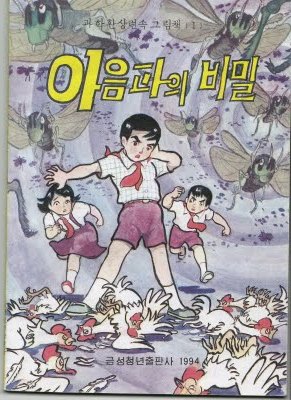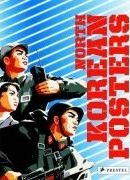UPDATE 2: (hat tip to a couple of appreciated readers) Park Soo-me reports on the proliferation of South Korean films in the DPRK:
“It’s safe to assume that a majority of North Korean residents have watched a South Korean film or a soap opera at least once,” said Kim, who left North Korea in 2004, and established a think-tank in Seoul called the “North Korea Intellectuals Solidarity.”
The group, which frequently communicates with their inside contacts in the North, recently broke revealing news that a group of North Korean students were caught watching “Haeundae,” a mega-hit South Korean disaster film locally released just over a month ago, at a computer lab inside a Pyongyang college.
The defector group cited an anonymous source in Pyongyang who told their reporter that the government is tightening a crackdown of digital files, as South Korean films smuggled through China are endangering the North’s dictatorial regime.
A student identified only as “Choi” said he had downloaded the film at his relative’s house in Cheongjin, a city about 50 miles from the Chinese border. He was arrested for promoting the ideology of his enemy state, not for circulating a pirated film.
Since the late 1990s, South Korean dramas and films were illegally traded in the North through local businessmen frequenting the Chinese borders. The phenomenon is not unlike that from the young Soviets in the 1970s, who secretly acquired rock ‘n’ roll records and American videotapes through its black market, despite the country’s ban on the cultural products of the capitalist state.
Last year, an insider from another defectors’ group based in Seoul broke news that DVD compilations of South Korean adult films and TV dramas are becoming popular in the North, as the sales of the average South Korean soap opera has declined in recent years. Such DVDs were found in a North Korean market in Cheongjin, the group said through its newsletter.
The situation in the North has gotten to the point where Oh Yang-yeol, a professor at the University of North Korean Studies in Seoul, published a paper on “Hallyu in North Korea: Now and Future.”
The term hallyu recalls the Korean wave of pop culture that hit Southeast Asia in the early 2000s. Oh’s paper stresses the spread of South Korean fashion, drama and music among the younger generation of North Koreans.
In a separate release by the Korean Institute of National Unification, experts have quoted North Korean defectors who have testified that South Korean melodramas like “Autumn in My Heart” and “Winter Sonata” have become a such hit in the North that a special squad was once organized to crack down on the violators.
But not all dramas smuggled into the North are soft, touchy-feely soap operas. Among the works that have been found and blacklisted by the Northern authorities include films like Park Chan-wook’s “Joint Security Area,” a story which is essentially built around a forbidden friendship between solders from the North and South who are stationed in the Demilitarized Zone that divides the two countries.
On the distribution side, South Korean films and TV dramas are appearing in the North faster and with a broader reach, as evident in the recent case of “Haeundae.”
“In the past, it normally took up to six months for a South Korean film to arrive in the North,” Oh said. “Now, it takes little over a month. In wealthier neighborhoods in Pyongyang we start to see local girls imitating the hairstyle and fashion of South Korean celebrities who starred in the latest TV dramas.”
Irritated by the spread of hallyu — often referred to as the “yellow wind” in the North — authorities have tightened censorship regulations and house inspections to encourage “ideological discipline.” But there is a limit as to what they can do.
Although limited to a privileged few, more computer-savvy Koreans in Pyongyang are finding easier alternatives to enjoy pop culture from the outside world, making the North’s isolation more difficult. Internet access is limited to an Intranet for most people in the North. But USB drives are becoming more common among local college and middle school students, and frequent traffic between North Korea and China is increasing opportunities for cross-border smuggling of pirated films from Hollywood and Seoul.
Read the full story below:
Pop culture making inroads into North Korea
Hollywood Reporter
Park Soo-mee
10/8/2009
UPDATE 1: Although the Donga Ilbo previously reported that the DPRK was growing more tolerant of foreign films (below), Channel News Asia reports the DPRK is clamping down:
The student in Pyongyang was caught on September 5 while watching a digital copy of “Haeundae” with his dorm friends, the North Korea Intellectuals Solidarity said in a newsletter posted on its website.
The student allegedly acquired a file of the film at a relative’s house in the northeastern port city of Chongjin and downloaded it onto his college computer, it said.
The case prompted authorities to launch an extensive probe aimed at preventing the spread of the movie, the group said, quoting a “correspondent” in the North.
The inspection revealed that tens of thousands of North Koreans have secretly seen foreign films, it said.
Defectors say South Korean pop songs and movies are popular in the isolated communist country, despite a steady campaign to weed out what state media has termed “decadent foreign culture and ideals”.
In December 2007, three North Koreans including a schoolteacher were sentenced to death for smuggling illegal adult films from China and South Korea, according to Good Friends, a Seoul-based aid group working in the North.
ORIGINAL POST: According to the Donga Ilbo:
Recently, the North has televised the shows “International Common Sense,” “Animals in the World,” and “Foreign Culture,” programs which had been abolished long ago. Those programs even show the daily lives of Westerners.
A few days ago, a video clip was aired in which North Korean singers in military uniform played the guitar and sang Italian songs. When broadcasting sports, Pyongyang used to simply air competitions in which North Korean athletes participated, but when airing the IAAF World Championship in Athletics in Berlin last month, the North summarized footage of major events and televised them.
North Korea’s attitude toward foreign movies has also changed. CD-ROMs containing foreign movies have been manufactured by the state-run Hana Electronics, which has sold them across the nation. Most of the CD-ROMs include foreign movies aired by Mansudae TV, which serves Pyongyang only.
A CD-ROM is priced at 1,500 North Korean won (41 U.S. cents) and a DVD goes for 7,500 won (2.07 dollars). CD-ROMs of cooking game programs as well as those on the lives of famous soccer players such as Diego Maradona and Franz Beckenbauer are also on the market.
The North has also embraced world-famous animated films. The Disney productions of “Cinderella,” “Pinocchio,” “Sleeping Beauty” and “Robin Hood” are available across the nation. The popular American cartoon “Tom and Jerry” is called “The Magic World of a Mouse” in the North.
The proliferation of foreign movies has also led to an increase in secret movie rental stores. Government-manufactured CD-ROMs can be rented out at 300 won (eight cents) per day and illegal movies can be borrowed at 500 won (14 cents) per day.
Yet most foreign programs broadcast in North Korea are created in China, which, in turn, has encouraged North Koreans to adopt the Chinese way of life. Mansudae TV routinely broadcasts Chinese soap operas like the drama “Unnamed Hero” and “Vertical Blow,” which shows the training of China’s special forces.
Despite the apparent liberalization of North Korean television, Pyongyang has toughened its punishment for those watching South Korean TV programs. In the past, punishment for watching a South Korean program was usually avoided through a bribe but the offense is now considered more severe than a drug-related crime.
Read the full story here:
N. Korea Growing More Tolerant of Foreign Movies
Donga Ilbo
9/19/2009



